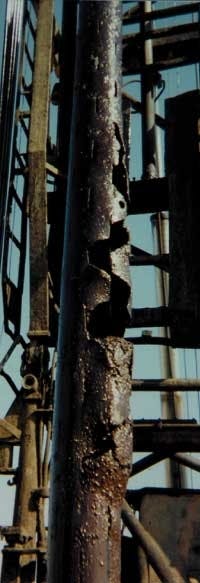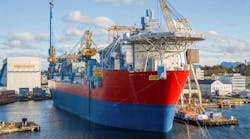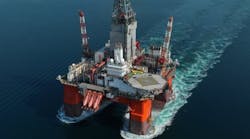Stuck pipe has been problematic to the oil and gas industry since the first wells were bored into the earth. Today, the problem of stuck pipe is estimated to cost operators more than US$1billion a year in lost rig time, lost production, the cost of fishing operations, and lost tools.
Downhole vibration technology, which has been successfully applied in the oilfield in the form of a recently commercialized system from Baker Oil Tools, holds promise as an effective, economical technique that can significantly reduce the time and cost associated with removal and recovery of stuck objects.
Many conditions can cause objects to become stuck in a wellbore - differential sticking, an undergauged hole, poor hole cleaning, and mechanical sticking to name a few. Current methods for recovering stuck objects include impact tools such as jars, washover operations, and milling tools. All of these operations have been used for many years, with varying success rates, certain risk factors, and questions such as:
- Will the stuck object part or split from jarring?
- Is the hole angle such that jarring will be ineffective?
- During washover and milling operations, what type of sticking, hole cleaning capabilities, hole angle, depths, and materials to be removed must be considered?
Alternate solutions
The concept of applying vibration technology to fishing operations dates back to the 1980s, with Tri-State Oil Tools and A.G. Bodine pioneering early efforts. In 1991, Tri-State Oil Tools began operating what is now known as the surface oscillator or surface resonance tool.
The surface resonance tool mounts at the top of a heavyweight drill pipe work string. A hydraulic system, pressured by a diesel-powered pump, delivers power to hydraulic motors that turn counter-rotating eccentric weights to stimulate the entire string into a vertical sinusoidal motion.
A reduction in operating time is common with vibration methods. A typical job for the surface tool takes only a matter of minutes to free a stuck object. Movement of the fish accelerates as the process progresses, and stops when vibration ceases. The fish moves as long as there is enough vibrational energy to overcome friction. Vibration of drill pipe has been reported as reducing friction by a factor of 100. This translates into lower overpulls, resulting in reduced tension on the rig and string.
Under proper conditions, surface oscillation techniques have achieved a 90% success rate in recovering liners, tubing, and drill pipe, ranging in length from 30 ft to more than 700 ft. However, the technique is limited by well depth and borehole orientation. Surface resonant systems cannot be placed directly at the stuck point.
Downhole resonance
Both the advantages and limitations of surface resonant technology guided the development of the industry's first downhole resonance system. The primary focus was to lower the cost associated with the recovery and removal of stuck objects. A secondary consideration was to design a tool that would be operational in highly deviated wells.
At one time, it was thought that a surface tool could have a high success rate in highly deviated wells. Data tracking has shown that this is not the case. Jars also have difficulty in highly deviated wells. Being able to place the vibration downhole, closer to the stuck point, yields a substantial savings in cost of operation, and can potentially have a higher success rate in removing stuck pipe.
Baker Oil Tools recently commercialized the Rattler, a downhole resonance system designed to operate directly at the stuck point. The system, powered by surface pumps, begins operation at a pump rate of approximately 1bbl/minute (bpm) with an operating frequency of 12 Hz. The operating frequency varies with pump rate and is completely independent of overpull.
Testing
The first primary Rattler test objective was to establish the effects of the system on 180 ft of sand-stuck tubing. This length was selected based on similar tests pulling 60 ft and 90 ft of sand-stuck tubing with a less powerful version of the tool. Additionally, a comparison test was carried out to determine the effect of a standard hydraulic jar on the same tubing. A secondary objective of the testing was to determine the effect of moving the source of vibration away from the stuck point.
The bottomhole assembly (BHA) for the tests consisted of an overshot, ported sub, the downhole resonance tool, oil jar, 90 ft of 4 3/4-in. drill collars, 3 1/2-in. IF drill pipe to surface, and a kelly.
In the first test, 180 ft (6 joints) of 2 7/8-in., 8-round tubing was placed inside 7-in., 26-lb casing, and sanded into place. The tubing was run one joint at a time with new, dry 12/20-sized sand. The annulus was then filled with water to surface. The sand was allowed time to settle, after which the BHA was run in and the fish was engaged with an overshot.
With the string in neutral weight, the pumps were started and the downhole resonance tool put into operation for several minutes to vibrate and pack the sand. After giving the sand additional time to settle, a 40 klb (1 klb = 1,000 lb) overpull was taken to set the overshot and verify that the string was indeed stuck. The jars were fired at 60 klb.
Without resetting the jars, pumping was started at a rate of 2.0-2.5 bpm, activating the downhole resonance tool. A 4-6 klb overpull was then placed on the string. Jarring and vibration were alternated to observe the effects of each retrieval device on the fish, with any movement of the string noted.
For the first test, the sand was allowed to settle around the fish for only an hour. Hydraulic jars moved the fish uphole 7 in. after being set off three times. Using the downhole resonance system, the fish was moved upwards 7 in. within a minute of operation. The fish was vibrated back to its original position (down 14 in.) within two minutes.
After the sand settled overnight, the test was repeated. This time, jarring had no effect on the fish. The downhole resonance tool moved the fish 6-in. in less than one minute with a pump rate of 2.5 bpm, while maintaining a 4-8 klb overpull on the string. Another attempt with the jars was performed with no movement of the string. Vibration was used a second time with a 4-8 klb overpull, and the fish moved 3 ft in two minutes. Jarring was attempted for a third time and again did not move the fish.
To observe the effects of moving the source of vibration from the stuck point, two joints of PH-6, and a joint of 2 7/8-in., 8-round tubing (about 90 ft total), were inserted between the overshot and the downhole resonance tool. The fish was caught as before and vibration commenced. After vibrating on the fish and observing no movement, the 2 7/8-in., 8-round tubing was removed and another attempt to move the fish was carried out.
No jars or drill collars were included in this string due to the depth of the well. With 90 ft between overshot and the downhole resonance tool, the tool was unable to move the fish, now stuck to a depth of 177 ft. However, after removing the joint of 2 7/8-in., 8-round tubing from the string, the fish was moved 3 ft in two minutes, using an overpull of 4-8 klb.
Field trials
Field trials were carried out to evaluate tool performance and to help determine which applications were the best candidates for success. The wells attempted ranged in depth from 600 ft to 7,100 ft. Operation of the tool was observed at the surface as indicated by vibration felt in the workover string. Results were observed almost immediately and were clearly visible as a change in weight on the weight indicator.
- Eugene Island, Gulf of Mexico: This offshore well had two 7 5/8-in. packers set 27 years ago at 6,900 ft and 7,140 ft MD, at a hole angle of 25 degrees. A jar was used on the initial attempt to recover the first packer. The packer separated after two hits from the 4 3/4-in. jar. Three additional trips were made to finish recovering the packer and remaining pieces. The Rattler system was used on the second run. After shifting the release sleeve and relatching into the top of the packer, a 30 klb overpull was attempted. The packer did not come free. The overpull was slacked-off to 4 klb and the Rattler activated by pumping at 1.0 bpm. The entire packer was free in less than a minute.
- Kern Front, Bakersfield, Calif.: An 1,800-ft vertical well was completed with 98 ft of 6 5/8-in. 24-lb slotted liner. The objective was to recover the liner using the 2 7/8-in. production tubing and downhole vibration. Drill pipe, collars, and jars were never delivered to the site. After latching onto the fish, a 43 klb overpull was attempted on the string to verify that the spear was set and the liner firmly stuck. The pump was started and adjusted to 3 bpm.
After several minutes, the downhole resonance tool began operation. The weight indicator began to show a loss of weight almost immediately. The liner was extracted by maintaining a 30-40 klb overpull on the string as the liner was worked free by the downhole resonance tool. After 30 minutes, the liner was moved 25 ft. The pumps were stopped to remove a joint of tubing. Flow was again established and the liner pulled completely free 10 minutes later. There was no damage to liner, spear, tubing or rig.
- Midway Sunset, Bakersfield, Calif.: A failed gravel pack bridged off and left a 750-ft, 5 1/2-in. 17-lb slotted liner sanded up somewhere between 434 ft and 474 ft MD. The fishing operator originally speared into the first joint of the liner and had problems with the spear pulling free during jarring. He then put a joint of drill collar between the spear and the stop sub to catch the second joint of the liner. Jarring was continued. After 1 1/2 hours, a downhole resonance tool was called on site. After running in hole with an 11 klb working string, a 49 klb overpull was attempted to set the spear 12 ft into the first joint. Pumping was begun at about 2 bpm. The weight indicator showed a drop off of weight almost immediately, settling down to the weight of the working string and the liner (25 klb). On pulling out of the hole, it was observed that jarring had split the first 4-5 ft of the liner at the first joint. There was splitting in the second joint of liner as well.
- Kern Ridge, Lost Hills, Calif.: This well was drilled and completed in 1925. Subsequent workover activity was sketchy. It was expected that the 58 ft of 6 5/8-in. liner would be aged permanently into place, or have nothing left. The downhole resonance tool was run on 2 7/8-in. production tubing and the liner was caught at about 636 ft. A 44 klb overpull was attempted to set the spear and see if the liner would come free. Pumping was initiated at a rate of about 3 bpm. After several minutes, the weight indicator began to show a drop off of weight. However, once the liner began to move, it moved rather quickly, coming free after 5 minutes of vibration. Once out of the hole, the liner's true condition could be seen. There were large gaping holes throughout the length of the liner. The bottom 8-10 ft of the liner were filled with sand that had resettled from a washout run 2 days prior. The spear had caught in the adapter on the first joint. The liner appeared to be very fragile. It is possible that one hit with a jar would have parted the liner or split it, making further recovery attempts very difficult.
Rig testing and field trials of the Rattler downhole resonance system confirmed that, while not always possible with jars, and never possible with surface resonant systems, it is possible to place a downhole resonance tool immediately above the catch device. The trials also confirmed that downhole vibration can be effective in situations where jars are not, and that it can be used in conjunction with jars if desired. Other advantages, including cost reductions and operability in deviated wells, are also evident.
Moving forward
While not the ultimate, final solution to the problem of stuck pipe, it is estimated that using downhole vibration technology in fishing operations can reduce costs by extracting pipe that might not be extractable by other methods. The full range potential of downhole vibration technology has not yet been fully explored. Research and development are continuing, with expanded field testing underway.
Among issues to be determined from the additional field testing are: the amount of time spent vibrating in an attempt to extract stuck pipe, and whether to vibrate first on tubing, run jars first, or run jars in conjunction with a downhole resonance tool.
Authors Note: This article contains information originally presented in SPE Paper 63129 at the 2000 Society of Petroleum Engineers Annual Technical Conference and Exhibition. References available on request.







